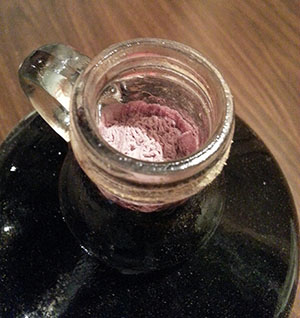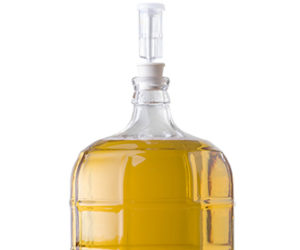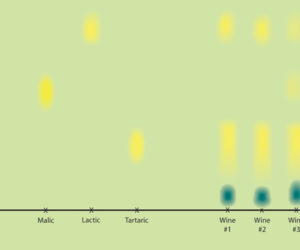 Q
Q
My father-in-law makes wine from grapes, de-stemmed and put in pails. He does the usual vatting and filtering and transferring demi-johns, etc. Once the wine is ready, we put it in gallon (3.8 L) bottles and store it in our basement cold cellar until we need some, at which time we transfer it into 750 ml bottles. When we open the gallon (3.8 L) jugs, there is sometimes (not always) a topping of what appears to be mold or something. It doesn’t smell or anything. The father-in-law says to carefully remove it, but often some bits remain, which we filter with a strainer when bottling. The wine always tastes fine, but I wonder if it is okay to drink?
Ron Wilson
Hamilton, Ontario
A
Thanks so much for sending over the pictures, they are very helpful. Even though it’s impossible for me to diagnose down to the organism just based on images, I’d wager you’ve got a very thick colony of spoilage yeast growing on top of your gallon jugs. Sometimes called “film yeast” and similar to the classic “flor yeast” bloom intentionally encouraged to live on top of wine during Sherry production in Spain, these are aerophilic organisms that can metabolize ethanol, glycerol and organic acids as food. If conditions are right, they can grow to such an extent that they form the white fluffy colonies on the surface of the wine. Though they can be Saccharomyces species, film-forming yeast colonies can also be comprised of Pichia, Candida and Hansenula strains.
I’m glad that, even with these visible spoilage colonies, you’re finding that the wine tastes fine. The wine should also be safe to drink and not poisonous for any reason (unless something funny was added to it!). To quote one of my favorite UC-Davis professors, the newly-retired Dr. Linda Bisson, “No human pathogen can survive in wine.” What she means is that no bacteria or virus that can harm you can live in the high-acid and high-alcohol environment of table wine. There’s a reason the ancient Romans and Greeks used wine as an antiseptic in their ancient medical practices.
It’s a shame, though, to put all your hard work at risk. I wonder why you don’t just bottle all the wine at once? You’ll protect the wine from a high-oxygen environment and will develop secondary (and in most cases, desirable) bottle bouquet aromas and textures by doing so. I always say that “wine ages better in the bottle” meaning after it’s done with its bulk aging for about 9 months for a still white wine like a Chardonnay to 12-18 months for a bigger red like a Cabernet, the wine will most safely and gently develop in the bottle.
If you don’t want to bottle it all up at once for whatever reason, there are some steps to take if you still choose to store your wine long-term in jugs. Here’s a list:
• Don’t over-feed your fermentations. An often-overlooked source of spoilage organisms is “leftover” yeast nutrient from the primary fermentation. If there are excess nitrogen or micronutrient molecules in the wine after the primary fermentation is complete, they can unintentionally nourish undesirable yeast and bacteria.
• Make sure that your wines are stored with enough Free SO2 to help keep the microbial population at bay. I tend to shoot for about 28–35 ppm FSO2. You don’t want to add so much that it affects the taste and aroma of your wine but you want some in there to be effective at least against some of the organisms.
• Make sure your wines are fermented dry. Residual sugar and residual malic acid are just invitations for spoilage yeast to take hold.
• Don’t constantly open up your carboys and storage containers. Opening your storage containers (carboys, barrels, etc.) after the wine has finished fermenting not only lets in oxygen but also potential spoilage organisms. If you must open a carboy, spray the surface of the wine and underneath the cap with a strong SO2 solution before you close it up.
• Use an air filter (UV) in your cellar. To cut down on ambient spoilage organisms, I’ve heard some wineries, caves and cellars are having success installing air filters that rely on UV light to kill microbes.
• Keep cellar temperature low. Higher temperatures encourage spoilage growth whereas cold temps suppress it. Even a 10 degree Fahrenheit change, like 52 °F (11 °C) rather than 62 °F (17 °C), can make a big difference.
• Try for lower pH wines. The higher the pH (and the lower the acid) the higher the chance you’ll experience populations of spoilage yeast and bacteria. Even big rich red wines can be delicious at a pH of 3.45-3.55 so if you want to thwart oxidative and microbial spoilage in your wines, this is one thing to consider.
I hope that this gives you some direction for how to curb those unsightly white film yeast colonies. Eventually they can oxidize and spoil your wine so the next jug you open you might not be so lucky. I very much recommend that you bottle your wine all at once instead of leaving it so vulnerable in gallon jugs.
Q
I have been making wine since 1998 and it has been a great hobby. I have made wine from both kits and grapes, and recently tried my first cider. Some wine kits come with 1 or 2 packages of yeast. A recent Winexpert kit I made used EC-1118 and Bourgorouge RC212. Questions: What do the 2 yeasts do, versus just using 1? Do they compete somehow? When I make wine from grapes, how do I know I am adding enough yeast, if these special kits add 2 packages?
Bob Kyle
Michigan
A
Good for you for branching out. Apple cider has astronomically increased in popularity in the United States in the past few years and I see an increasing number of wineries trying their hand at the fermented-apple beverage.
But back to the questions at hand. As to your wine kit coming with two packets of different yeasts (and I have no idea what the instructions say): Is it possible the kit says to choose one or the other? Do the directions say to use both? My first instinct would be to follow whatever the directions say, to the letter. A lot of test batches have been done on these kits before they are released in order to arrive at the given ingredients and instructions provided.
If none are given, then my next instinct would be that, if each packet is sufficient to ferment the batch size (see addition rates on page 18), you are to choose one of the yeasts only. Part of this reason is that EC-1118 and RC212 are very different yeasts. EC-1118 is also known as Prise de Mousse or “PDM” and is considered the biggest workhorse yeast strain in the wine industry. It is not nutritionally fastidious, ferments rapidly and cleanly, isn’t fussy and importantly, contains a killer factor that allows it to out-compete most other strains. RC212 is interestingly known as being a classic yeast for Pinot Noir production though there’s no reason it couldn’t make a wide array of wines.
It is possible that you are supposed to use both yeast strains, just at different times and for different purposes. If your kit has you making a sparkling wine, it’s possible that the RC212 yeast is intended for the first yeast fermentation, where the sugar from the juice is transformed into alcohol and carbon dioxide. The EC-1118 yeast, therefore, is intended as the “secondary” fermenter, or the yeast that you’ll add when you dose the new still wine with a little “priming sugar” and a little yeast before you bottle. EC-1118 is a strong yeast and, of the two, would be the most likely to survive the relatively inhospitable conditions found in a higher alcohol wine.
It is also possible that the kit intends you to use these yeast together in the fermentation, all at once in a single vat. Sometimes we winemakers do this in order to engender complexity in the aroma and mouthfeel of a wine, though the practice is not without risk. Generally, if two (or more) yeast strains are present in a fermentation, they may compete for resources (nutrients, minerals, nitrogen, etc.) and will end up causing a troubled and potentially stuck fermentation. Sometimes, however, it can work out and in this case, with RC212 and PDM (EC-1118), I think it could. If you co-inoculated (the term for using more than one yeast strain simultaneously) with both of these yeast at the same time, or even got the RC212 started before pitching the EC-1118 around 4–8 °Brix drop, you could end up with characteristics of both strains in the ferment. Some complexity from RC212 with the assurance that EC-1118 would finish the job in case the RC212 was not up to finishing the task.*
So what’s the intention of your kit maker in giving you two packets of different yeast strains? I have to admit, I’m not really sure, not having access to your instructions. One thing that can help you figure it out is to weigh out the yeast in each packet to see how much you have. Hopefully, your kit maker will have the weight nice and spelled out on the package, but if not, you can weigh out the yeast if you have a gram scale that weighs in the 1-100 g range. Keep in mind that the typical calculation most large-scale winemakers use is 2 lbs. of yeast per 1,000 gallons juice (0.24 kg/L). That is, for every 1,000 gallons (3,785 L) of juice you want to ferment (and for red grapes assume about 165 gallons/ton or 0.69 L/kg yield) budget adding 2 lbs. (0.91 kg) of yeast. Most yeast come in 500 g packages, which is just about exactly one pound (1 lb. = 454 g). To run through the math, 2 lbs./1,000 gallons is about 908 g/3,785 liters or about 0.24 g/L or about 0.90 g of yeast per gallon of juice. If you’ve got 1 g/gallon (0.26 g/L) of yeast, then that means you have enough of one yeast strain to ferment the whole batch. If you have only 0.5 g/gallon (0.13 g/L), that means, barring any other instructions, the kit makers meant you to use both yeast strains.
Don’t forget that you could just throw all of this to the four winds and just buy enough of another yeast strain from your friendly local winemaking supply store (or the interwebs) to ferment as many gallons as you want with whatever yeast strain you want. This is just my attempt to interpret what the kit makers were trying to tell you.







